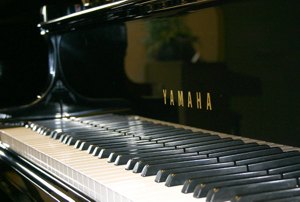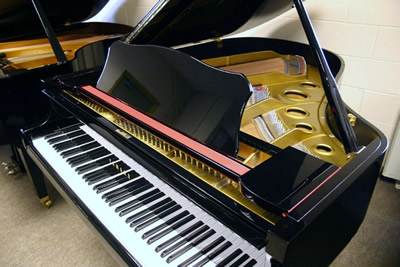
Introduction
In 1902, Torakusu Yamaha, founder of the Yamaha Corporation, built the first Yamaha grand piano. Two years later, the Yamaha grand piano won the Honorary Grand Prize at the St. Louis World's Fair. Today, the Yamaha C series grand piano is easily the most recorded and recognizable piano in the world.
Overview
The C3 is a 6'1" grand piano and is commonly found at recording studios and conservatories all over the world. Its 6'1" length, duplex scale, tone collector system, Ivorite keytops, superb construction and finish make the C3 a fine piano to play and own.
Sound
A Yamaha piano just isn't a Yamaha piano if it doesn't have clear, crisp tones and a descent bass range—well this C3 piano delivers. At 6'1", we got a taste of the "real bass" feel found in larger grands and it had excellent dynamics too—allowing for a smooth transition from ppp to fff comfortably.
The C3 is designed with a duplex scale—the non-speaking portion of the piano strings (located between the bridge pins and hitch pins). The purpose of the duplex scale is to add fullness and color to the sound. The metal tone collector is also worth talking about. It connects to the back posts and the iron plate of the piano allowing sound energy to transmit through the piano's case for a fuller longer lasting tone.
Touch
The C3's keytops are fabricated with Ivorite, a synthetic "Ivory" substitute. We liked the Ivorite touch for a couple of reasons: First Ivorite, like Ivory, is porous and gives the pianist better grip over the plastic keytops found on smaller pianos. Second, again like Ivory, Ivorite has a dull finish and won't reflect light nearly as much as white plastic keytops do—a bad thing especially during a recital or performance.
We liked the feel of the keyboard. The keyboard was very solid and well regulated. If you're used to playing on a well maintained piano, the C3 shouldn't be a problem for anyone to get used to.
Construction
We were impressed by Yamaha's construction methods which included their vacuum molding process for eliminating imperfections in the iron plate, pins having lathe cut threads for optimal grip in the pinblock and the pinblock being sealed to protect against fluctuations from humidity. All of this gives the C3 superior tuning stability.
Yamaha's commitment to quality, however, doesn't end there. Yamaha makes it a point to let the C3 settle in an environment similar to its destination before shipping and then seals the piano in an airtight container. C3 owners will also enjoy complimentary service visits 3 to 8 months after delivery and after 8 months. All of this service ensures that your piano will perform just as beautifully as the day you played it in the showroom.
Lastly, the Yamaha C3 comes in the choice of Polished Ebony, Satin Ebony, Polished White, Satin American Walnut, Polished Mahogany, and Polished American Walnut to match your décor.
Conclusion
Overall, we were very pleased with the C3. We love the way it sounds, feels and looks. The craftsmanship was excellent and we were impressed with Yamaha's construction techniques and complementary service visits. At an estimated price tag of around $25,000, the Yamaha C3 is very well priced and will provide enjoyment for generations to come.


